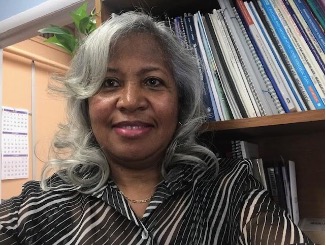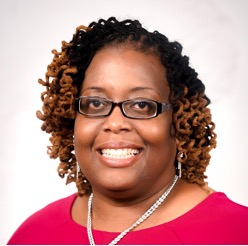
Prince George’s County Public Schools’ Future Ready Schools® Leaders, Lisa Spencer; Sarah Thomas, PhD; and Kimberly Roberson, are leading the way.
When Lisa Spencer learned that the pandemic was going to shut down in-person learning at Prince George’s County Public Schools (PGCPS), she knew prior initiatives to support teachers creating content for online learning was going to change from voluntary to mandated. Serving as the district’s executive director for instructional technology and support, Spencer pulled her team together, including Sarah Thomas, PhD, regional technology coordinator, and Kimberly Roberson, technology trainer, to put together a plan that would scale to the far-reaching corners of the district.
The team had a solid foundation and technology strategy and according to Roberson, “… we were working on building capacity following our joining the [Future Ready Schools] network. We went from a few schools to everyone buying in across our large district.” Since signing the Future Ready Schools® (FRS) pledge four years ago, PGCPS has been using the FRS framework to prepare and protect their district for a time such as the pandemic. PGCPS is located just east of the nation’s capital on the Maryland side of the Potomac River. It comprises 207 schools with more than 136,000 students and over 9,000 teachers, allowing the district to maintain an enviable 15:1 student-teacher ratio.
Even with so many teachers, Spencer, Thomas, and Roberson confidently moved forward with training as many fellow staff members as possible to become proficient at creating and implementing online learning. An early challenge for Spencer and her team was measuring the efficacy of instructional activities from a distance. As a district, PGCPS had already adopted Canvas as their learning management system and rolled out with an “opt-in” choice to surface the most enterprising teachers for the initial cohort. Keeping the vision clear, Spencer said, “We’re trying to mentor the use of tech in learning to generate results.” Successful usage of the tools wasn’t as obvious for PGCPS building administrators and instructional technology staff members as when conducting in-person observations. Spencer asked, “Are they continuing based on the training or regressing?”
One of the evergreen values of the FRS framework is its compatibility with other more acute frameworks for teaching and learning transformation. When thinking about scaling such work, Roberson said that Royce Kimmons’s, Charles Graham’s, and Charles West’s PICRAT (passive, interactive, creative, replacement, amplification, and transformation) framework for technology integration is an example of such a complementary framework they’ve successfully implemented at PGCPS. Roberson said, “It’s similar to SAMR (substitution, augmentation, modification, and redefinition), but PICRAT focuses on the student perspective, which aligns with the Future Ready component for Curriculum, Instruction, and Assessment in an intentionally learner-centered and personalized instructional design.”
“We want the teachers to be more mindful of tech integration,” Spencer said. She continued, saying, “This has been transformative because PICRAT gave us a view of instructional design to help teachers understand why they’re planning and designing learning like they do. When you’re using PICRAT, you learn to question what’s being asked of both teacher and learner. PICRAT helps us as a team determine whether one activity or tool is being used effectively to impact teaching and learning.”
Spencer’s team is very aware of the way teachers and learners are adapting to new ways to engage. Roberson said, “During quarantine and learning from home, we offered emergency remote learning plans. We now have teachers who are all over the three sectors: remote, hybrid, face-to-face.” Like in most districts, the PGCPS instructional technology team recognized that the teachers were under immense pressure to acquire new methods and develop new content at a rapid pace just to keep up with the next school day; the next period; and the next email, call, or Zoom meeting.
Staying above the fray and not forsaking best practices became primary objectives for the team. They relied upon the FRS framework to put structure in their professional learning interventions and ad hoc technology changes. Returning to the FRS framework in the crisis of the pandemic grounded Spencer, Thomas, and Roberson.
Roberson said, “When we started with the Future Ready framework four years ago, it helped us move edtech outside the tech department. It initially let us help others understand community partnerships and the other components as well.” She continued, saying, “We want them to return to thinking about the entire FRS framework. It’s not just about tossing something into NearPod or Canvas. Now we know all of our teachers are equipped with the devices and techniques and we need to move to the next level. Now we’re looking to convert ideas into action and do so collaboratively to maximize personalized learning and professional learning by way of the edtech we employ.”
Keeping the entire learning community informed and on board was also a part of the team’s considerations, and again, they aligned themselves with the FRS framework for support with home and community communication engagement. Thomas said, “Our parents are invested in the learning community, even more so since the shutdown. They became our true partners as the teachers at home, needing practical information from logging into learning spaces.” Roberson added, “We now have a common language around tech integration that bridges between more tech-savvy teachers and those who have been struggling. Ideally, we would want to showcase various ways to solve the same problem with different approaches.”
Sustaining the changes that were implemented during the pandemic is a concern for districts across the nation, regardless of their size. The PGCPS team shared their thinking as it aligns with the Budget and Resources procurement supports of the FRS framework. Spencer said, “We’ve utilized some of the Title IV funding for software, but to be able to continue usage, we’ve been able to roll Canvas into the general operating budget strand to keep the investment’s value beyond the [Elementary and Secondary School Emergency Relief] funding. Now we’re reflecting on the user data to determine what tools are providing a return on instruction. Now we’re more mindful in procurement looking ahead.”
Though district budgets have increased in the past year, managing scarce time is even more of a concern for leaders such as the PGCPS team. Spencer said, “You can’t deploy too many options in balance with clear expectations for use of procured solutions.” Speaking of a prior initiative, she explained, “We did this by working with curriculum and instruction [gear of the FRS framework] to frame up these expectations and examples for how to introduce certain tools.”
This sort of collaborative leadership builds trust and preempts future success. Spencer said, “We’re continuing to fortify that working relationship, especially for what can or cannot be a mandate. The district leadership cabinet needs a clear vision for how these solutions and training are going to mature. If there are some expectations for ‘how the head turns, the body follows,’ decisions can be made with higher efficacy in how the tech department and champions for using technology to design and deliver new learning experiences for a district with administrators and teachers.”
The PGCPS team is energized about the potential growth as a result of the district’s successes enduring the most strenuous part of the pandemic and has a focus on infusing even more personalized professional learning. Thomas said, “We are excited about our partnership with Common Sense Media for digital citizenship, kicking off our fifth cohort. We’re three years in and built a program that allows teachers to earn certification—with the support of our Common Sense representative—to put together webinars, live sessions, and other self-paced resources for learning, and earning a certificate from their reflection and research.”
Looking back, Thomas said, “We’ve really seen an increase in building capacity with both staff members and students. I’m proud of our team as far as their growth.” She and her team are hoping to hold onto the gains they experienced in improving learning from anywhere as they move PGCPS forward.
About the Authors

Lisa Spencer
Lisa Spencer is the district’s executive director for instructional technology and support at Prince George’s County Public Schools (PGCPS) in Virginia.

Sarah Thomas, PhD
Sarah Thomas, PhD, is the regional technology coordinator at Prince George’s County Public Schools (PGCPS) in Virginia. Year.

Kimberly Roberson
Kimberly Roberson is a technology trainer at Prince George’s County Public Schools (PGCPS) in Virginia.
